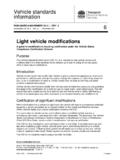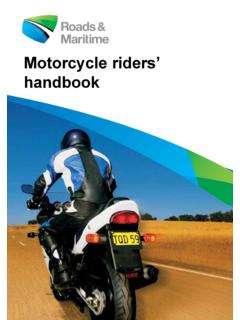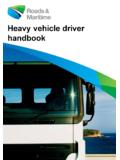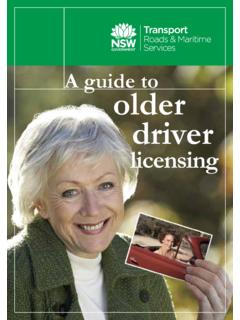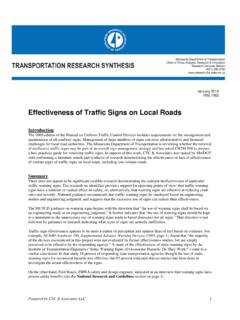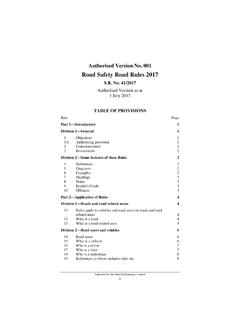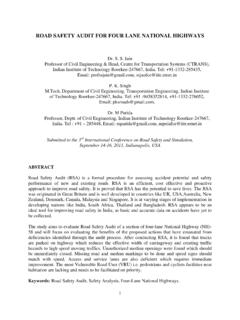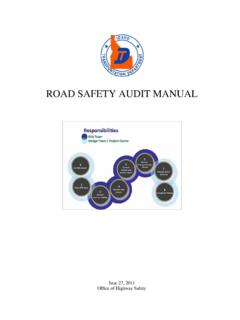Transcription of Speeding fact sheet 6 - Safe System - the key to …
1 Speeding - Did you know? FACT sheet 6 of 6 safe System the key to managing road safety 1. What is the safe System approach to road safety ? The safe System approach advocates for a safe road System , better adapted to the physical tolerance of its users. The safe System was officially endorsed by the Australian Transport Council in 2004 and adopted by all Australian state and territory road authorities, including NSW. It has guided the development of subsequent National road safety Action Plans and underpinned the development of the National road safety Strategy for 2011 to 2020.
2 The setting of speed limits is now based on this approach so that avoiding death and serious injuries, becomes a priority. 2. Who developed it? Australia s safe System approach shares principles in common with well known national strategies such as Sweden s Vision Zero and the Netherlands Sustainable safety approaches. Sweden s Vision Zero approach Vision Zero was adopted by Sweden in 1997 and has the long term goal of eliminating death and serious injury from the road transport System . Under this approach, it is unacceptable to trade off human life and health for other benefits of the transport System (eg mobility).
3 The Netherlands Sustainable safety approach The Sustainable safety approach was launched in the Netherlands in the early 1990 s. It aims to prevent road crashes or at least minimise their severity while allowing for human capacities and limitations. The approach recognises that human beings are susceptible to injury and prone to errors. Sustainable safety aims to prevent these errors as far as possible or to reduce their consequences by allowing for human limitations in designing the traffic System . Australia s safe System approach Australia s safe System approach reflects international best practice as defined in the Organisation of Economic Cooperation and Development s (OECD) landmark report Towards Zero: Ambitious road safety Targets and the safe System Approach.
4 This report was prepared with substantial involvement of Australian road safety officials and practitioners. The safe System approach represents a significant shift in thinking about road safety . The safe System will deliver reductions in deaths and severity of injuries by coordinating the management of all the components of the transport System that impact on safety . 3. What are the principals of the safe System approach? While the safe System approach to road safety recognises the need for responsible road user behaviour, it also accepts that human error is inevitable.
5 It therefore aims to create a road transport System that makes allowance for errors and minimises the consequences - in particular, the risk of death or serious injury. By taking a total view of the combined factors involved in road safety , the safe System approach encourages a better understanding of the interaction between the key elements of the road System : road users, roads and roadsides, vehicles and travel speeds (see diagram below). Roads and Traffic Authority of New South Wales | 13 22 13 July 11 RTA/Pub. Despite the System allowing for human error, if drivers are exceeding the safe speeds the safe System approach will not be as effective.
6 Controlling driver Speeding behaviour is critical to the success of the safe System approach. Source Australian Transport does the road user benefit?The safe System approach to road safety recognises the need for responsible and compliant road user behaviour,but also accepts that human error is inevitable. It therefore aims to create a road transport System that makesallowance for errors and minimises the consequences -: in particular, the risk of death or serious safe System aims to have alert and compliant road users and has three core components: safe roads and roadsides - a transport System designed to make a collision survivable through a combination ofdesign and maintenance of roads and roadsides.
7 safe vehicles - the design of vehicles and their safety equipment to include protective systems includingelectronic stability control, air cushions, etc. safe speeds the speed limit should reflect the road safety risk to the road three core components operate in an environment where road users are encouraged to be alert to risk and compliant with the rules of the System . Through a combination of these components, the safe System approach aims to design and build a transport System that will protect road users and reduce the number of deaths and serious injuries.
8 Critical a factor is speed in the safe System approach?Achieving a safe System of road travel is based on an understanding that the human body is vulnerable and unlikelyto survive an uncushioned impact at a speed of more than 30 km/h. Even relatively low speeds can kill or seriouslyinjure unless the vehicle and the road and roadside environment take account of the physical vulnerability of all roadusers. The main objective of the safe System is to ensure that in the event of a crash, the impact forces released arewithin the boundaries of human tolerance and that no fatalities should occur and serious injuries are chances of surviving a crash decrease rapidly above certain impact speeds, depending on the nature of the collision.
9 The diagram and table below show the estimated crash impact speeds based on the safest vehicles, where the forces are likely to exceed the tolerance of the human body, , those crashes that are likely to result in death Roads and Traffic Authority of New South Wales | 13 22 13 July 11 RTA/Pub. or serious injury (Austroads: Balance between Harm Reduction and Mobility in Setting speed Limits: A Feasibility Study.) IMPACT SPEEDS ABOVE WHICH CHANCES OF SURVIVAL DECREASE RAPIDLY Crash Type Impact speed Example Car/Pedestrian or Cyclist Car/motorcyclist 30 km/h Where there is a mix of vulnerable road users and motor vehicle Car/Pole or Tree 40 km/h Where unprotected road hazards exist within defined clear zone.
10 Car/Car (Side impact) 50 km/h Where there is a likelihood of side impact crashes (eg, intersections or access points). Car/Car (Head-on) 70 km/h Where there is no separation between opposing traffic streams important is speed management in the safe System approach?Of the elements in the safe System approach, speed management is critical in limiting the impact energy of crashesand underpins almost every consideration involved in the development of new and existing safety safe System approach maintains that travel speeds as well as roads, roadsides and vehicles should be designed and managed to reduce the risk of crashes and prevent serious injury or death to people in the event of a crash.

